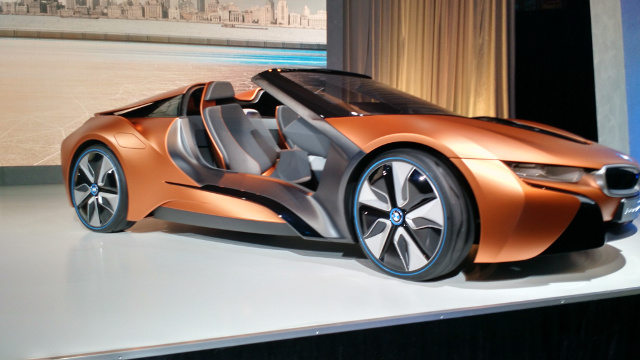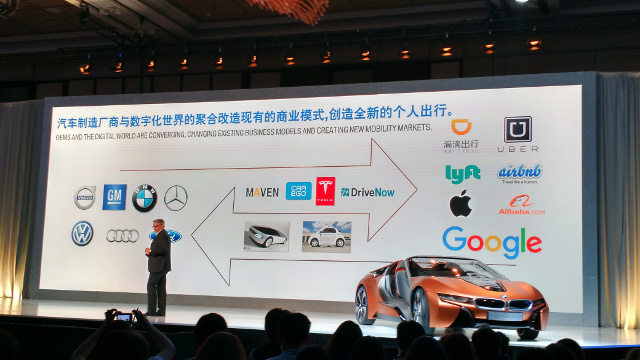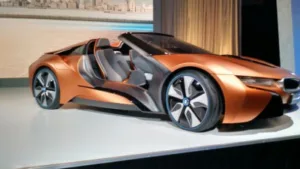Two BMW speakers used a keynote address at CES Asia to lay out their vision of the future of automobile. Naturally, it will be autonomous, but it will also be a hub of personalized information that will help increase efficiency and enjoyment in the car.
BMW is celebrating its 100th anniversary and BMW Group Region China CEO and President, Olaf Kastner, drove onto the stage in the company’s latest concept car, due for production in 2018. He highlighted some of the leadership BMW has already shown that is moving toward their vision of the future of automotive. For example, the company’s i3 electric and i8 hybrid cars, first introduced in 2013, are a key part of the “future of sustainable mobility,” as he put it. Going forward, they are monitoring social and technical trends to be sure they stay on top of these changes.

Today, BMW has highly automated features on some cars including lane keeping, object/people/animal avoidance and self parking. The driver still has control of the brakes and steering wheel, but in a fully autonomous driving mode, he can “turn his brain off” and do something else.
But a fully autonomous vehicle raises many legal, moral and ethical issues which means the solutions to these problems need to be dealt with soon to catch up with the technology. As Norbert Hildebrand has pointed out in his reporting on this topic, who will be responsible if the software caused an accident? And what happens if you don’t do a software update? (Harmon, among others, is working on this – Man. Ed.)
Kastner then ran a short film on the capabilities of the new concept car, which is still a prototype. It shows how the executive of the future will get to work in the morning. This starts with the car asking if he is ready to go and then self driving from the garage to the front door. The canyon road looks clear, the weather is great, so it’s a nice morning to enjoy the drive with manual control. Once in traffic, he is advised to change to a new route. He then voice commands the car to call the office, switch to fully autonomous driving mode and activate the 3D video conferencing call so he can review a new design element with an assistant. Once at the office, the car drives off to park itself.
Next, Dr. Rene Reiss noted how the firm is customizing BMW Connect, their vision of how data will be collected, analyzed and personalized for the individual, to the Chinese market. Chinese roads and drivers are quite chaotic so this will be a very big challenge for autonomous driving software. He said that the role of the car is being redefined as the ultimate smart device (does that mean a changing in branding from the ultimate driving machine?). He sees a future where you may be part of pool that owns a vehicle or fleet of vehicles at your beck and call. He also pledged to install 1500 charging stations in China by the end of 2016 and last week BMW launched their new lab portal. This allows drivers to test development phase features before they are finalized so as to gather consumer feedback.
BMW has a very robust natural language recognition system as well so you can speak freely about what you want to do or where you want to go. It is then intelligent enough to activate the resources to get the desired result, like finding stores for certain types of clothes or restaurants with the desired ethnic food.

He said that the “OEMs and the digital world are converging, changing existing business models and creating new mobility markets.” As a result, BMW wants to “create the future.”
Analyst Comment
The promise of autonomous driving sounds enticing – who would not want to be more productive, more entertained or more relaxed when stuck in traffic or enduring long drives? But the legal and social consequences may well indeed trump the technical challenges – which will surely be solved soon. Anyone who has been in China knows how chaotic the roads are. There is no respect for the dotted white lines or double yellow lines. There is no yielding to pedestrians or other motorists – including reams of scooters and bikes. The roads are like a giant game of chicken to see who will yield first. Can an algorithm duplicate this? But more importantly, should it? This is an inherently dangerous model, so adopting safe autonomous driving will likely mean a complete change of the social driving patterns in China – which seems far-fetched or at least a long term challenge. It will certainly be interesting to see how this plays out. – CC
On the other hand, France was a country that was renowned for ignoring motoring rules until a government campaign of enforcement showed how lives could be saved, and the atmosphere on the roads has changed dramatically, and quickly. (BR)

